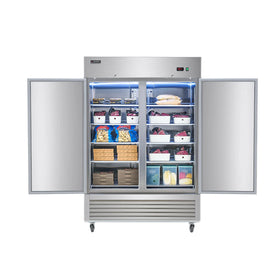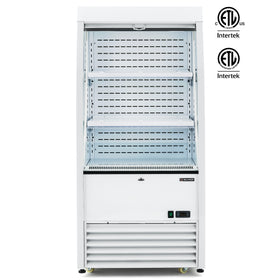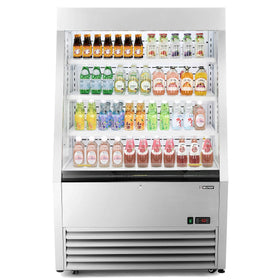If you have any surplus vegetables, do not hesitate to freeze them: most vegetables freeze quite well and can stay for up to 8 months in the fridge. Some texture change is normal, but the flavor and nutrients will hold up if stored right.
However, not every kind of vegetable is suitable for freezing. Moreover, whenever you freeze vegetables, the water inside turns into ice crystals, and they might get soft and watery when you cook them.
This is why it is necessary to understand how freezing works and how different vegetables might respond to the process.
Here is a detailed guide to freezing vegetables: fresh vegetables, cooked, or roasted vegetables. We also have some tips for which vegetables to freeze and which not to.
Freezing Fresh Vegetables
You can freeze fresh vegetables, but in order to preserve the texture, you must blanch them first, precool in the fridge (if freezing large batches), and put them in a single layer on an aluminum baking sheet.
Follow these steps:
- Wash and prep your veggies. Trim, peel, and cut into bite-sized pieces.
- Blanch by boiling or steaming for 2–4 minutes, depending on the veggie.
- Shock in an ice bath to stop the cooking instantly.
- Drain and dry thoroughly (towels or salad spinner help).
- Pre-cool in the fridge (optional, but useful for large batches). This helps reduce internal temperature evenly before freezing.
- Pre-freeze in a single layer on an aluminum baking sheet, not stacked. This speeds up the freeze and gives you that coveted IQF result.
- Transfer to bags/containers once frozen. Use freezer-safe bags, and push out as much air as possible or vacuum seal if you can.
How to Manage Ice Crystals When Freezing Vegetables
When you freeze vegetables, the water freezes and becomes crystals. These hard crystal balls then puncture the cell walls of your veggies and cause them to lose their structural integrity. This explains why frozen vegetables are often watery when cooked.
The best vegetables to freeze are those with lower water content. When freezing vegetables, follow these tips:
- Freeze fast to keep those ice crystals tiny.
- Pre-cool large batches in the fridge to avoid uneven freezing.
- Avoid freezing warm food—it creates zones of semi-freezing that damage the texture.
- Freeze in thin layers on a cold surface (like an aluminum tray on the freezer floor).
- Once frozen solid, store in airtight containers to prevent moisture loss and freezer burn.
Freezing Cooked or Roasted Vegetables.
If you have already roasted or cooked your veggies, you can still freeze them, as long as you portion them accordingly and pack them in airtight containers or freezer bags.
Here’s how you freeze cooked vegetables.
- Let them cool completely.
- Portion into meal-sized servings.
- Pack in airtight containers or freezer bags.
- Label and date so you know what’s what.
Steamed, sautéed, or boiled veggies freeze well and are a go-to for meal prepping. Just make sure they’ve cooled before packing them up.
Root vegetables like sweet potatoes, squash, carrots, parsnips, and beets freeze especially well when roasted. Softer roasted veggies (like zucchini or tomatoes) might go mushy, but still work great in soups or sauces.
Should You Blanch Your Vegetables Before Freezing?
Almost all commercially frozen vegetables are blanched before freezing. Blanching helps to preserve color, flavor, texture, and nutrients. It also slows the enzymes that cause vegetables to deteriorate, even in the freezer.
However, not all vegetables must be blanched before freezing. If you are freezing raw vegetables, there is no need to blanch them.
Freezing Raw Vegetables (No Blanching)
Some raw vegetables can go straight into the freezer without blanching. Just wash, chop, and bag.
However, not every raw vegetable freezes well. Lettuce, cucumbers, and radishes have high water content and tend to turn soggy if frozen raw.
| Freeze | Do Not Freeze |
| Onions | Lettuce |
| Bell peppers | Cucumbers |
| Garlic | Radishes |
| Celery | |
| Fresh herbs like parsley, cilantro, and dill |
Tips for Freezing Vegetables
- Use aluminum baking sheets for faster heat transfer. Freeze in a single layer directly on the tray surface.
- Souper Cubes, ice cube trays, or muffin tins are perfect for freezing small portions of pureed or chopped veg.
- Vacuum sealers are your best friend for long-term storage and preventing freezer burn.
- Dry ice method: Want pro-level freezing at home? Alton Brown swears by dry ice in a cooler to flash-freeze veggies. Just wear thermal gloves and be safe.
- Liquid nitrogen (advanced): If you’re feeling serious and safe, dip veggies in liquid nitrogen to flash freeze them individually. Then vacuum seal. This method creates the smallest ice crystals possible, protecting texture and flavor. Do your homework first.
- Block freezing: For certain veggies, you can freeze them submerged in water. This helps prevent freezer burn for long storage, but it works better for some textures than others.
Vegetables You Should Not Freeze
- Tomatoes: Best roasted and then frozen, or consider canning or drying.
- Mushrooms: These freeze poorly raw. Better to dry them or cook them before freezing.
- Herbs: Freeze on their own, or suspended in oil or water in ice cube trays, depending on the herb.
Do Restaurants Use Frozen Veggies?
Many restaurants use frozen vegetables, and it’s more common than people think, even in some higher-end establishments.
Freezing vegetables in a commercial freezer (not just a regular refrigerator) works because it rapidly brings the temperature down to a point where microbial growth stops and enzymatic activity slows way down, preserving the food.
Here’s a breakdown of how and why freezing vegetables in commercial freezers works
- Most bacteria and fungi can’t grow below 32°F (0°C), and commercial freezers go even lower (often -10°F to -20°F / -23°C to -29°C).
- Fast freezing (like in blast chillers or commercial freezers) prevents nutrient loss that happens over time in fresh produce. Enzymes in veggies keep working after harvest and can cause spoilage or texture changes — freezing halts that process.
- Small crystals are gentler on the cell structure of the vegetable, preserving texture better.
- Slow freezing (like in home freezers) creates large crystals that damage the cells and make veggies mushy when thawed.
- Commercial reach-in refrigerators are built to maintain steady sub-zero temperatures, even with frequent opening/closing during busy kitchen service.
- With a commercial refrigerator, more powerful fans and better airflow ensure even freezing across large batches.
So, vegetables are frozen using commercial-grade freezing equipment, often immediately after harvest, which keeps them fresher for longer.
Here are 5 best commercial refrigerators you can probably afford
How to Cook Frozen Vegetables Without the Mush
Frozen veggies sometimes get a bad rap for turning into sad, soggy piles. Here’s how to cook them for better results:
- Steam, don’t boil. Steaming helps veggies stay tender without going watery.
- Roast from frozen. Toss with oil and seasonings and throw them on a hot pan in the oven. Total game-changer.
- Skip the skillet (unless you're quick). Pan-frying can create uneven results—some mushy, some undercooked.
- Don’t overcook. A little texture goes a long way, especially with broccoli, cauliflower, or carrots.
Overall, Freezing Veggies is a Good Idea.
Frozen veggies aren’t just convenient—they’re a legit way to stretch your harvest, your grocery haul, or your meal prep. With a few smart techniques, you’ll have bright, flavorful veggies on hand anytime you want them, minus the food waste, mush, or mystery bags in the back of the freezer.
You might also be interested in how to store apples, and if you have spices and condiments to freeze, here is the correct answer to one frequently asked question: Can you freeze celery?











